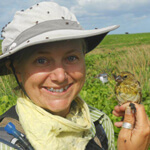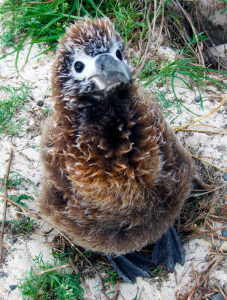Return to Laysan
8 April 2013
Michelle Wilcox

The critically endangered Millerbird. Scientists are tracking the growing number of Millerbirds on Laysan Island. Photo: Robbie Kohley
Editor's Note: This post resumes our series with scientists on Hawai'i's Laysan Island in the Papahānaumokuākea Marine National Monument, where they are following up on a multiyear effort to establish a population of the critically endangered Millerbird. Two translocations of Millerbirds from Nihoa Island to Laysan were completed in 2011 and 2012, and scientists are now monitoring breeding success and tracking the growing number of Millerbirds on the island. The effort has been carried out by a team of biologists from the U.S. Fish and Wildlife Service and American Bird Conservancy.
After being closed since November, the camp on the 1,016-acre coral atoll known as Laysan Island reopened in late March and is now staffed with five U.S. Fish and Wildlife Service personnel and two Millerbird biologists.
I was lucky enough to return to Laysan Island along with Megan Dalton, the newest biologist. Together we will continue monitoring the newly translocated Millerbirds to try to determine how many survived the winter and then monitor them throughout the summer. We hope to discover how many new chicks have fledged and where on the island they are living. In the first couple of weeks, we have already seen more than 38 individual Millerbirds and are expecting to find even more in time.

Laysan Island's human population. Back row, left to right: Andrea Kristof, Justin Yeh, Andy Bridges, Ian Thomas. Front row, left to right: Brianna Ordung, Megan Dalton, Michelle Wilcox. Photo: M. Dalton
The birds began nesting on Valentine's Day last year, so we predicted they would be nesting when we arrived this year. The birds are indeed busy, and Megan and I have found six pairs nesting so far. Three pairs have nests with chicks in them, and three pairs are building nests. Additionally, we have found males defending new territories adjacent to the area they favored last year. The naupaka shrubland on the north end of the island appears to be the Millerbirds' favorite area.
Although Millerbirds are our focus here on Laysan, our “Nature Sight of the Week” is the tens of thousands of Laysan Albatross chicks sitting all over the island. Their parents had just started arriving in the fall when we left, and the island is now a very different place, so much more full of life and activity. There is a grey, downy chick the size of an overweight bowling pin under my clothesline. During the heat of the day he waddles unsteadily into the shade of my weatherport platform, but he must return to the patch of ground where he hatched or his parents will not feed him with regurgitated fish, fish eggs, and squid when they return from foraging flights, which can cover thousands of miles.
The Laysan Albatross do not begin breeding until around their eighth year of life, but starting at age three they begin to return yearly to Laysan during the breeding season to practice their courtship dance, to find and defend a territory (males), and to find a life-long mate. This means that in addition to the chicks and their itinerant parents, there are tens of thousands of young adults on the island who spend most of their days calling, clacking, and dancing. What a life!
In addition to the Laysan and Black-footed Albatross, there is one lone Short-tailed Albatross who returned again this breeding season to what we call the “northeastern desert.” Along the brine lake edge, we have seen two Ruff, four Long-billed Dowitchers, two Red Phalaropes, and 12 Sanderlings, in addition to the large numbers of Wandering Tattlers, Pacific Golden-Plovers, and Ruddy Turnstones. We have seen one Cattle Egret near the grove of coconut tree snags, and we have seen a good number of Bristle-thighed Curlews around the island.
We plan to post these blogs every two weeks, sharing updates on the status of the Millerbird population, stories about specific individuals, and information on all the other natural and unnatural wonders on Laysan. See you again soon!
 Michelle Wilcox is a Millerbird biologist with American Bird Conservancy.
Michelle Wilcox is a Millerbird biologist with American Bird Conservancy.



















































